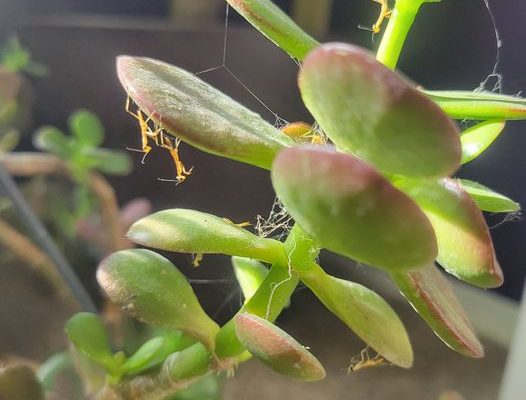Plus, the feeding sites provide excellent places for fungi to infect the roots.
Neem oil and isopropyl alcohol are the two most effective natural means. But always test your treatment on one of the leaves a day before to ensure it isn’t sensitive to these substances.
Neem oil is the go-to mealybugs jade plant treatment for most indoor plant infections due to its non-toxic nature and effectiveness.
One of the advantages of using neem oil is using it as both a soil soak and a foliar spray. Let the soil dry out slightly between waterings to ensure that root rot doesn’t become a problem.
Jade Plants that seem soft or discolored likely need less watering and more sunlight. Jade Plants should be dark green with firm leaves and stems.
Dilute concentrated neem oil to avoid chemical burns. Plants are often sensitive to pure neem. They usually congregate on the stems and undersides of leaves.
These jade plant mealy bugs feed by piercing the plant’s tissue and sucking out its juices, which can weaken a jade plant over time.
To do this, first emulsify water by mixing ⅓ teaspoon of insecticidal soap, pure castile soap, or Dawn dish soap into a quart of water.
The soapy water loses surface tension, allowing the oil to mix.
The more practical route for an infestation of mealybugs is a neem soil drench or soak using 100% percent raw neem oil.
Add 1 ½ teaspoons of raw neem per quart of emulsified water. Pour 2 to 3 cups of the soak over the soil.
Not only will the neem soak kill any root mealybug, fungus gnats, and other houseplant bugs but the roots ingest the oil and turn it into a systemic insecticide.
Any houseplant pests that pierce the plant, such as mealybugs or scale insects, will ingest the neem. They will lose their appetite, fail to reach the next growth stage, and become infertile.
NOTE: This treatment won’t immediately kill the jade plant mealybugs, so it might take two weeks to see results.
The soak remains potent for up to 22 days. Reapply every three weeks as a preventative measure.
Neem Foliar Spray
Neem foliar sprays use one teaspoon of clarified hydrophobic neem oil per quart of emulsified water. Apply using a spray bottle.
Spray the entire plant, especially the undersides of leaves and any small crevasses.
Spraying will affect the younger nymphs, but their waxy coating protects adult mealybug bodies.
Reapply the spray every other day for at least two weeks. It works best when combined with the soil soak.
Both isopropyl and rubbing alcohols can wipe out a mealybug infestation with excellent success rates. But it is time-consuming.
Take an alcohol-soaked cotton swab and lift each leaf to access the mealybugs. Two-spotted spider mites, Tetranychus urticae, like to sip on jade juice occasionally. These have light-colored bodies with two dark spots.
You will have to touch every jade mealybugs with the swab for the treatment to be effective. But the rubbing alcohol quickly dissolves the protective waxy coating and kills the bug in the process.
This method works well on a newly infected plant but is primarily useless against a bad infestation.
Using Natural Predators Outdoors
In the event your jade plant is growing outside, you can use some natural garden pest exterminators.
Lacewings , lady beetles , and parasitic wasps are all effective mealy bug killers. Mites are tiny, eight-legged creatures that can spin webs like spiders and suck the sap from your plants.
They will also protect your outdoor plants against many other insect pests. But ants will sometimes try and defend mealybugs and other honeydew-producing insects.
For obvious reasons, this isn’t a good option for indoor plants. It can work wonders on outdoor specimens or if an indoor jade plant can spend some time on the porch.




